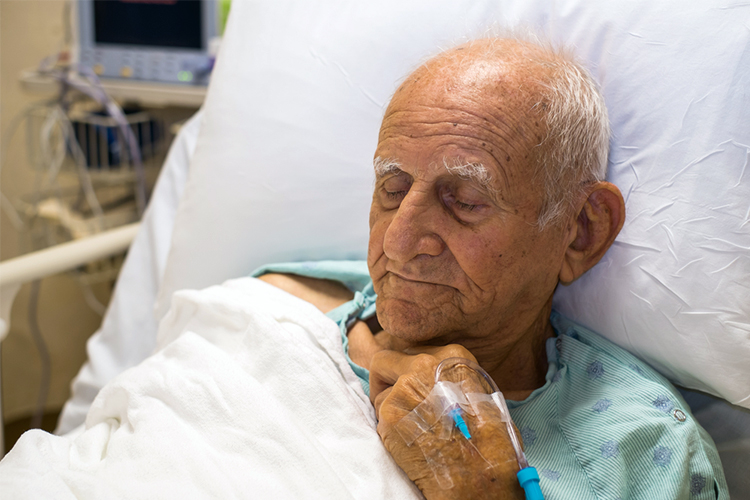What is Delirium?
Delirium is a common disorder that mostly affects older adults. However, it doesn’t discriminate, and can also affect young people - especially following surgery.
It is an acute cognitive state that causes the patient to experience fluctuating disturbances such as confusion, disorientation and reduced awareness (Mayo Clinic 2022).
The Difference Between Delirium and Dementia
Other causes of cognition changes, such as a pre-existing dementia, need to be ruled out before a diagnosis of delirium can be made. As the symptoms of delirium and dementia are similar, delirium can sometimes be misdiagnosed as dementia.
It is also important to note that up to 60% delirium cases go unrecognised (de Lourdes Ramírez Echeverría et al. 2022).
One of the main differences between delirium and dementia is that delirium is a reversible condition, whereas dementia is not. This is why a diagnosis of delirium is essential in order to effectively reverse the condition. If this does not occur, treatment and consequently, recovery, are delayed, which can have many negative impacts on the patient and their family.
Delirium also develops over a short period of time in comparison to dementia. Dementia can be quite insidious with its progression. It takes a longer time to develop and is a degenerative disease process.
Delirium can often be a direct physical consequence of a general medical condition, such as a fluid-electrolyte imbalance following surgery. It is not a degenerative process, rather, one linked with a specific medical condition that has caused changes to the individual's normal homeostasis and bodily function (Koutoukidis et al. 2017).
This is why obtaining a comprehensive history of the individual is essential, as well as performing frequent cognitive and physical assessments, in order to gain information regarding their current status and ensure the diagnosis of delirium is timely and accurate.

Signs and Symptoms of Delirium
The diagnostic criteria for delirium under the DSM-5 include:
- Impaired consciousness (decreased clarity of awareness of the environment) with decreased ability to focus, maintain or shift attention
- Changed cognition (e.g. memory impairment, disorientation, language impairment, perceptual impairment) that cannot be attributed to dementia
- Cognitive disturbance that develops over a short period of time (hours to days) and fluctuates during the course of a day
- Evidence (history, physical assessment or laboratory findings) that suggests the cognitive disturbance is directly related to a medical condition, an intoxicating substance and/or medication use.
(Alagiakrishnan 2019)
Postoperative Delirium
Postoperative delirium is, as the name suggests, a delirium that presents in individuals following surgery. It can be triggered by a variety of factors including:
- Fluid and electrolyte imbalances
- Dehydration
- Hypoxia
- Hypercarbia
- Acid-base disturbances
- Infections such as respiratory, wound or urinary tract infections
- Medications including anticholinergics, benzodiazepines, opioids and central nervous system depressants
- Unrelieved pain
- Blood loss
- Decreased cardiac output
- Vertebral hypoxia
- Heart failure
- Acute myocardial infarction
- Hypothermia or hyperthermia
- Unfamiliar surroundings and sensory deprivation
- Emergency surgery
- Alcohol withdrawal
- Urinary retention
- Fecal impaction.
(Alagiakrishnan 2019; Farrell & Dempsey 2013)
There are also certain risk factors individuals can have that increase their risk of developing postoperative delirium. These include:
- Being an older adult (aged over 65 years)
- Being male
- Having several comorbidities
- Dementia
- Renal impairment
- Sensory impairment
- Alcohol use disorder
- Functional disability.
(TeachMe Surgery 2020; de Lourdes Ramírez Echeverría et al. 2022)
An important factor to remember is that often, this state of confusion can be an early indicator of infection, fluid and electrolyte imbalance or physical deterioration. This is why frequent mental and physical monitoring of someone experiencing from postoperative delirium is an essential part of surgical nursing care (Farrell & Dempsey 2013).
It’s important that the cause of the delirium is identified and then promptly treated in order to reverse the delirium. This is done in conjunction with the implementation of management strategies for the patient (Vijayakumar et al. 2014).
Management Strategies
Nurses can help implement strategies to assist in managing postoperative delirium in patients. In addition to closely monitoring the patient themselves, their immediate environment should also be assessed. The patient should be kept close to the nurses station for monitoring, have a well-lit room to assist with orientation, and, at the same time, care should also be taken to minimize any distracting or unfamiliar noises. A clock and calendar can also be placed in the patient's room to help improve their orientation. It is also important to ensure the patient has uninterrupted night-time sleep (Farrell & Dempsey 2013; Robinson & Eiseman 2008).
Staff should introduce themselves every time they come into contact with the patient as well as re-orientate them as often as necessary, even if this means every time they enter the room. Engaging the patient in conversation and involving them in any care activities that are occurring can also help in the management of postoperative delirium (Farrell & Dempsey 2013).
Safety issues should also be considered. These include the risk of the patient becoming agitated and inadvertently pulling out drains, tubes, or lines, as well as the increased risk of falling.
The patient should not be restrained, as this can worsen their confusion. Other options should be utilized instead, such as having a staff member or family member sit with the patient to ensure their safety. It is also important not to neglect physical activity in the individual during this stage as this can not only worsen the delirium but additionally place the individual at risk of other postoperative complications such as the development of pressure areas and deep vein thrombi (Farrell & Dempsey 2013; Robinson & Wiseman 2008).
Medication management of postoperative delirium, including the use of medicines such as lorazepam or haloperidol, should be avoided if possible, as these can have additional side effects for individuals. If the postoperative delirium has been attributed to pain or the use of certain analgesic medication, the nurse must ensure that the patient's pain is managed in a way that isn’t increasing their confusion (Farrell & Dempsey 2013; Marcantonio & Discussant 2012).
Outcomes
Postoperative delirium is a significant complication following surgery that may result in both functional decline and prolonged hospitalization. Postoperative delirium also increases the individual's risk of other complications while in the hospital, including falls and aspiration pneumonia (Robinson & Eiseman 2008).
The duration of delirium varies from person to person; roughly half of those with delirium will have their symptoms resolve within two days of onset. Another one-third will have symptoms continue until their hospital discharge. However, up to 50% of post-discharge patients will continue to show some signs of delirium one month following surgery (Marcantonio & Discussant 2012).
This is why it is such a significant complication of surgery. As nurses, we need to be aware of how we can implement strategies to assist the patient and their family with postoperative delirium.
Topics
References
- Alagiakrishnan, K 2019, Delirium Clinical Presentation, Medscape, viewed 13 October 2023, https://emedicine.medscape.com/article/288890-overview
- de Lourdes Ramírez Echeverría, M, Schoo, C & Paul, M 2022, 'Delirium', StatPearls, viewed 12 October 2023, https://www.ncbi.nlm.nih.gov/books/NBK470399/
- Farrell, M & Dempsey, J (eds) 2013, Smeltzer & Bare’s Textbook of Medical-Surgical Nursing, 3rd edn, Lippincott Williams & Wilkins, Broadway.
- Koutoukidis, G, Stainton, K & Hughson, J (eds) 2017, Tabbner’s Nursing Care: Theory and Practice, 7th edn, Elsevier, Chatswood.
- Marcantonio, ER & Discussant, SM 2012, 'Postoperative Delirium', Journal of the American Medical Association, vol. 308, no. 1, viewed 13 October 2023, https://www.ncbi.nlm.nih.gov/pmc/articles/PMC3604975/#
- Mayo Clinic 2022, Delirium, Mayo Clinic, viewed 12 October 2023, https://www.mayoclinic.org/diseases-conditions/delirium/symptoms-causes/syc-20371386
- Robinson, TN & Eiseman, B 2008, 'Postoperative Delirium in the Elderly: Diagnosis and Management', Clinical Interventions in Aging, vol. 3, no. 2, viewed 13 October 2023, https://www.dovepress.com/postoperative-delirium-in-the-elderly-diagnosis-and-management-peer-reviewed-fulltext-article-CIA
- TeachMe Surgery 2020, Delirium, TeachMe Surgery, viewed 13 October 2023, https://teachmesurgery.com/perioperative/general-complications/delirium/
- Vijayakumar, B, Elango, P & Ganessan, R 2014, 'Post-operative Delirium in Elderly Patients', Indian Journal of Anaesthesia, vol. 58, no. 3, viewed 13 October 2023, https://www.ncbi.nlm.nih.gov/pmc/articles/PMC4090988/
 New
New 
